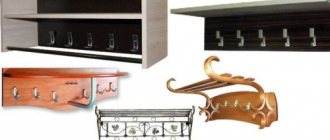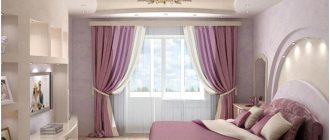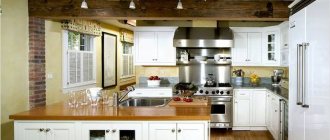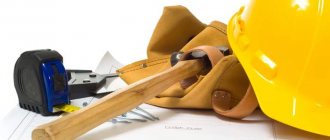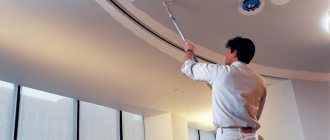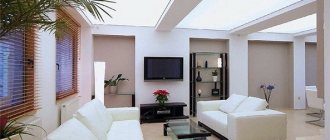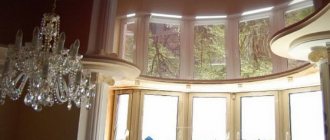Soundproofing the ceiling in an apartment from neighbors above is the most common problem that arises among residents of apartment buildings. The soundproofing of the ceiling in an apartment under a suspended ceiling will not be noticeable. so it’s doubly convenient. Stomping from above, falling objects, moving furniture and other impact noises top the list of irritants. And this is not surprising: an incorrectly executed floor in the apartment above you leads to exceeding the standards more than 20 dB! We analyze sound insulation options for suspended and suspended plasterboard ceilings.
Noise in the apartment and its acceptable level
Noise pollution of the environment is currently a very pressing problem. Exposure to high noise levels significantly increases the risk of various diseases. And we are not talking about extremely high noise levels , which can lead to hearing damage, but about noise levels that exceed the established and experimentally proven standard for residential premises.
This standard is called the permissible noise level.
According to the definition:
permissible noise level is a level that does not cause significant disturbance to a person and does not cause significant changes in the functional state of systems and analyzers that are sensitive to noise.
This means that if the noise in an apartment exceeds the permissible level, it is a source of significant concern for the residents of this apartment and causes significant changes in the functional state of systems and analyzers.
The permissible noise level for residential premises is as follows:
- during the daytime (from 7 a.m. to 11 p.m.), the equivalent sound level should not exceed 40 decibels (dBa) , and the maximum sound level should not exceed 55 dBa
- at night (from 11 p.m. to 7 a.m.), the equivalent sound level should not exceed 30 decibels (dBa) , and the maximum sound level should not exceed 45 dBa
Depending on the sources, noise in the apartment can be external or internal.
Sources of external noise are: transport, industrial enterprises, construction sites, advertising sound-reproducing installations, etc.
Sources of internal noise are located inside the building, for example: ventilation systems, elevators, pumping equipment or any other systems that ensure the functioning of residential buildings.
Types of noise and features of its distribution in different houses
To fully understand the issue, you need to know that 2 types of noise penetrate the room through the ceiling:
- airborne, caused by air vibrations (talking, singing, music, crying, dog barking, etc.);
- shocks generated by mechanical impact on the ceiling (stomping, moving furniture, hitting the floor).
Next, we will find out what technologies and materials will help protect the apartment from both types of noise.
And one more important point. Before you begin arranging soundproofing for the ceiling, you need to understand how noise coming from above spreads in different types of buildings.
- In a panel house, sounds from neighbors are transmitted through the ceiling itself and through the walls, so ideally, sound insulation will be required not only for the interfloor ceiling, but also for the partitions.
- In brick houses, walls dampen sounds, so it will be enough to insulate only the ceiling.
- In monolithic frame buildings, the partitions are thinner than the ceiling slab, so sounds travel primarily through them. In this case, the walls are the first to protect against noise.
Soundproofing the ceiling in an apartment under a suspended ceiling - review of materials
There are two types of sound insulation of walls and ceilings in an apartment: frame and frameless. The best way is to lay insulation on the floor of a neighbor's apartment, but this option is often not available. If a neighbor refuses to help reduce the noise level, then you can use the frameless ZIPS system, which is one of the most popular on the Russian market.
Soundproofing the ceiling in an apartment under a suspended ceiling can take the form of a module filled with glass wool. The advantages of this method of sound insulation include fire safety, good sound absorption, environmental friendliness of the material and hypoallergenicity.
Another option is Schumanet stone wool. The advantage of this material is that rodents and other pests do not live in it.
Comparison of materials:
| Material | Airborne noise insulation index in dB | Sound absorption coefficient, aw |
| ZIPS panels | 41 | 0,9 |
| ISOTEX | 22 | 0,4 |
| SCHUMANET - BM | 39 | 0,95 |
| EcoZvukoIzol | 38 | 0,9 |
If the sound level in the apartment exceeds the norm, it is best to use insulating material ZIPS or ISOTEX.
Soundproofing materials
Let's consider the features of common sound-reflecting and sound-absorbing materials.
- Plates made of basalt (mineral wool), polyester or fiberglass. They have an excellent noise absorption coefficient - up to 85%. Effective against any type of noise. They are usually mounted using the frame method. The only drawback is the large thickness. Well-known brands - Rockwool Acoustic, Schumanet, Stopzvuk, Aku-Light.
- Soundproofing membranes. They have a high density and small thickness - 2.5–14 mm. Due to their structure, they do not absorb noise, but reflect it, allowing for high-quality sound protection. The disadvantage is the high cost. The most well-known representatives are Tecsound (self-adhesive ultra-thin heavy membrane made from the mineral aragonite), “MaxForte” (composed of aluminosilicate fibers, a layer of one-component rubber), Fkustik-metal slik (foamed polyethylene and a lead plate 0.5 mm thick).
- Soundproofing panels. Due to the massiveness, multilayer structure, elastic-viscous consistency and free filler particles, both impact and sound energy are reduced. For example, “EcoZvukoIzol” from SoundGuard has a seven-layer cardboard profile filled with quartz sand.
- ZIPS. Sandwich panels of this system consist of gypsum fiber and mineral wool, are equipped with vibration units for fastening, are mounted on special fasteners without a frame, and are sheathed with gypsum boards on top.
USEFUL INFORMATION: How to insulate ceilings in an apartment and on a balcony with your own hands
- Cork. Natural cork material provides good sound insulation, but to achieve a significant effect, a thickness of several cm is needed. When using technical roll cork with a thickness of 10 mm, one layer will not be enough.
In addition to these materials, coconut coir, felt, liquid sound insulation and others are used for ceilings.
Preparing the ceiling for installation of sound insulation
Soundproofing the ceiling in an apartment - it is necessary to prepare the ceiling, which will help avoid peeling of the soundproofing boards. They do this in the following sequence:
- Remove old paint or other finishes. Clean the surface of the ceiling with a spatula, fill out cracks and joints where the putty does not adhere well.
- Treat the ceiling with a primer for concrete. Applying primer
- Seal cracks and joints using putty. It is not necessary to level the surface; the main thing is to carefully seal the cracks.
- If the width of the joints exceeds 1 cm, they can be filled with polyurethane foam.
- Dry the putty and prime the ceiling 1-2 more times. Between applying layers, the surface is dried for at least 4 hours. After preparing the ceiling, you can begin installing sound insulation using one of the technologies below.
How do ceiling soundproofing materials differ from each other?
For arranging a ceiling for sound insulation, materials with effective sound absorption are suitable. The arrangement of the ceiling is carried out using various methods; for each method, manufacturers of soundproofing materials have come up with their own option.
But no matter how good the noise-reducing material is, it must have the following properties:
- Soundproof - the sound wave is not absorbed, but reflected. The sound wave does not rock the ceiling because the material has decent mass and internal loss.
- Sound-absorbing - the sound wave is absorbed using special pore channels. The material has a fibrous composition, there is friction in the pores, which has the function of inhibiting the sound wave.
For arranging a ceiling for sound insulation, materials with effective sound absorption are suitable.
The sound wave may not penetrate the material, but it will rock and generate secondary noise, so it is better to use a structure with sound-absorbing material inside and massive sound-proofing material on the outside.
When choosing a material, you need to pay attention to the following indicators:
- Material thickness.
- Sound insulation coefficient.
- Flammability.
- Certificate of absence of substances harmful to the body.
Soundproofing the ceiling in an apartment, modern materials and installation
The following materials are considered the most popular today:
- mineral wool. Material made from raw materials with non-flammable properties. It does not shrink, it can be purchased in sheets with a thickness of 5 cm. Find out the price of mineral wool.
- mineral slabs are a convenient material to use , and the method of sound insulation with cotton wool is considered the most effective. But in this case the ceiling will become 15-20 cm lower. So, increasing the thickness of the ceiling structure is not always a good option, especially if the ceiling height is not satisfactory. Another disadvantage of cotton wool is the danger to human health. High-quality insulation will be required so that the material does not have a negative impact on humans. polyurethane foam. The sound-absorbing material has a tight grip, so it can protect against impact and airborne noise. The material absorbs not only noise from neighbors, but also sounds from your apartment. The disadvantage of polyurethane foam is its toxicity in case of fire. Therefore, such soundproofing arrangement is considered dangerous. sealing self-adhesive tape. This material is made from environmentally friendly raw materials and perfectly retains heat in the house.
Another disadvantage of cotton wool is the danger to human health. High-quality insulation will be required so that the material does not have a negative impact on humans.
- polyurethane foam. The sound-absorbing material has a tight grip, so it can protect against impact and airborne noise. The material absorbs not only noise from neighbors, but also sounds from your apartment. The disadvantage of polyurethane foam is its toxicity in case of fire. Therefore, such soundproofing arrangement is considered dangerous.
- sealing self-adhesive tape. This material is made from environmentally friendly raw materials and perfectly retains heat in the house.
A good option is the use of heat and sound insulating panels made from environmentally friendly pine wood fiber. There are alternative materials for soundproofing the ceiling. For covering the ceiling, for example, cork and foam sheets are used. Even with the advent of more modern materials, the love for cork cannot be changed.
But cork sound insulation is only suitable if your neighbors above have a concrete screed or laminate, and cork only saves you from impact noise. The screams of children, loud music, barking dogs - will be accessible to your hearing with cork sound insulation.
What do we soundproof: our ceiling or the floor of our neighbors above?
From an efficiency point of view, it is much better to soundproof the floor of the apartment located above. If you can reach an agreement with your neighbors, it will be cheaper to pay for soundproofing the floor in their home. Protection against impact noise with this approach will be significantly higher. Methods for soundproofing floors are described in detail in this article.
USEFUL INFORMATION: Ceiling made of MDF panels: do-it-yourself finishing
Installation of thin composite sound insulation with glue
The method is suitable for fastening sound insulation such as Maxforte Standard, Termozvukoizol, Texound 70, as well as for slab materials based on low-density basalt.
Advantages of the method:
- high installation speed;
- reliability.
Minuses:
- additional costs for glue;
- toxicity.
Required materials and tools:
- aerosol glue in a can;
- knife for cutting material;
- roulette.
Installation technology:
- Prepare the ceiling surface.
- The glue is sprayed onto the surface of the insulation, evenly distributing it from the can over the entire surface. It is better to do this outdoors or with open windows due to the high toxicity and pungent odor. Spraying aerosol glue
- Immediately glue the insulation to the ceiling.
- Installation of insulating material Wait for the glue to dry, after which you can install the suspended ceiling.
Installation of slab semi-rigid sound insulation with glue
This method is suitable for slab soundproofing materials, such as Maxforte EcoPlita and Shumanet BM, with a density of at least 30 kg/m³. Sound insulator Shumanet BM
Advantages of the method:
- saving time - no need to install the sheathing;
- minimum gaps and sound-conducting elements;
- ease of installation.
Minuses:
- extra costs for glue and dowels.
Required tools and materials:
- cement or gypsum based adhesive;
- spatula for applying glue; sharp knife for cutting slabs;
- roulette;
- drill or hammer drill;
special plastic dowels of the “mushroom” type, 5 pieces per slab.
Technology for installing slab semi-rigid sound insulation with glue:
- Prepare the ceiling using the above technology. Wait for the primer to dry completely.
- Mix the required amount of glue according to the instructions indicated on the package.
- Apply glue to the slab over the entire surface in a thin and even layer using a spatula.
- Laying the slabs begins from one of the walls, fitting them tightly to each other.
- Additionally, the slabs are secured using mushroom dowels. To do this, holes are drilled directly through the glued slabs with a depth of 50-60 mm greater than the thickness of the insulation. Drive dowels into them, 5 pieces per slab - in the corners and in the center. The dowel head should press the slab tightly.
- Wait for the glue to dry and begin installing the stretch ceiling.
Suspended ceiling with a frame made of soundproofing boards
An affordable and popular method is covering the ceiling with mineral wool slabs. It has been proven that such material can absorb up to 90% of noise, and installation of the structure is simple.
Installation of a ceiling with mineral wool slabs consists of installing a special design , in the cells of which noise-insulating material is placed. After the frame is filled with cotton wool, the structure is sheathed with plasterboard. A smooth surface can be painted, plastered, or wallpapered.
You can install a suspended ceiling yourself, how to do it? Installation instructions are the same as for soundproofing plasterboard ceilings:
- The space for the frame is marked.
- The suspended structure is assembled using slats or hangers.
- Soundproofing boards are installed in the resulting cells: mineral wool or fiberglass.
- The soundproofing material is hemmed with a decorative coating.
Installation of a suspended ceiling with mineral wool slabs can be done in another way:
- We install guides for the anti-vibration system on the ceiling.
- For ceilings with defects, you will need a surface primer.
- We use rolled material for sound insulation, gluing it to the surface, then additionally strengthen it with hangers.
- After the material is securely fixed, we assemble the profile.
- We fasten the profile around the perimeter, mount sheets of drywall or other material to the frame structure.
- We decorate the ceiling structure: paint it, cover it with wallpaper.
You can install a suspended ceiling yourself, how to do it?
If you have settled on a suspension system, then it is most logical to use cotton wool; installation of polystyrene foam is also allowed. just can’t stick foam plastic , over time it will move away from the ceiling, forming an empty space.
The suspended ceiling structure not only protects from noise, but also hides any unevenness, giving the ceiling a very beautiful appearance.
Installation of sound insulation on the frame
This method is suitable for slab or roll materials based on basalt and mineral wool or fiberglass of any thickness, including multilayer construction.
Advantages of the method:
- there is no need to drill the ceiling for mushroom dowels - the material is placed flat and holds tightly;
- You can build a structure of any thickness.
Minus:
- unnecessary expenditure of time and money on the construction of the frame.
Required materials and tools:
- guides for a frame made of a wooden block or galvanized metal profile;
- damper tape made of foamed polyethylene to dampen impact noise;
- drill or hammer drill and dowels for fastening the frame;
- metal scissors or jigsaw for cutting frame material;
- knife for cutting insulation;
- tape measure, marker.
Technology for installing sound insulation on a frame:
- Markings are applied to the prepared ceiling for attaching the frame. The frame is a lattice made of a bar or profile with a pitch equal to the width of the soundproofing material minus 2-3 cm. This will allow the material to be laid closely and without gaps.
- Cut the material for the frame using a jigsaw or metal scissors. Cutting material for the frame
- A damper tape made of foamed polyethylene is attached to the back side of the profile. It usually already has an adhesive layer, so it is installed quickly and easily. Gluing damper tape
- Drill holes in the ceiling and attach the profile or block to the dowels.
- If the soundproofing mats are of significant thickness, the profile is mounted on suspensions with acoustic decoupling.
- Plates of soundproofing material are placed between the resulting frame. Laying sound insulation If laying is carried out in two layers, the second row is laid with offset seams so that the center of the slab overlaps the gaps of the first row.
Cheap and simple materials for sound insulation
So, having examined modern soundproofing materials for walls, ceilings and floors, we move on to traditional products that have been used in construction for a long time. One of them is acoustic foam.
Let's start with the fact that foam rubber is made using the technology of pressing and forming products from polyurethane foam. Polyurethane itself is an excellent heat insulator, so acoustic foam easily copes with insulation tasks. But its main function is to protect premises from sounds.
At the same time, it protects against both wave noise and vibration. It has a good service life, and it can be installed on the surface, either in one layer or in combination with other building materials. For example, with thermal insulation.
This material is produced in slabs measuring 1000x2000 mm, with a thickness of 10-120 mm. It is available in different colors on the market. But the main distinguishing feature of the models among themselves is the relief surface, or rather, its configuration or shape. The soundproofing qualities of the material and its thickness depend on the depth of the relief.
Acoustic foam rubber “Pyramid” Source www.kombik.com
Soundproofing the ceiling in a low-density apartment
When using mats or rolls based on low-density mineral wool, you may encounter the problem of sagging of the material. It is solved by securing soundproofing mats with dowels and twine.
Low-density sound insulation installation technology:
- A timber frame is mounted on the prepared ceiling using the method described above.
- Soundproofing mats or rolls are placed between the frame bars.
- A vapor barrier film is laid on top of the soundproofing layer, securing it to the frame bars using a construction stapler.
- Additionally, the structure is secured with dowels at the rate of 5-6 pieces per square meter of ceiling.
- To avoid caking and sagging of mineral wool, a cord or twine is pulled between the dowels, creating a lattice or mesh over the entire surface of the ceiling.
Soundproofing options
You may have heard that suspended ceilings independently cope with the problem of sound insulation - after stretching them, you will no longer listen to the news on your neighbors’ TV? This is a myth - a tension structure with PVC film or fabric alone is not capable of cutting off sounds.
A stretch ceiling allows you to realize interesting design ideas at a very low cost. Moreover, you can order a color version or a canvas with 3D printing
But the opposite situation can very well happen - if the ceiling is fixed too low from the floor slabs, reflection of sounds can occur, the so-called “drum effect”. Similar reviews can be found many times on the Internet.
And the only solution to this problem is to dismantle the canvas, fill the space with several layers of soundproofing materials and reinstall the stretch ceiling.
Sound absorption systems are made using frameless and frame technology. Moreover, the latter can be carried out using vibration suspensions or according to the installation scheme of a self-supporting ceiling , when the frame is fastened between the walls.
The figure shows a schematic representation of the design of a self-supporting ceiling of the German brand - Knauf P131 (P 231). It is made of super sheets on one frame
You can also use the simplest option - fix sound-absorbing mineral plates and stretch a PVC sheet under them at a distance of 2 cm.
This option will allow you not to worsen your living conditions after installing suspended ceilings, avoiding the “drum effect”. But with the absorption of noise from neighbors, you will get a rather modest result.
Which technology to choose depends entirely on the characteristics of the room and the expectations of the owner. The first is convenient and easy to install, taking up little space. But to implement a frame ZIK, you will need not only experience in attaching profiles, but also more space under the ceiling.
As for installing the structure, if you have no experience in performing repairs, it is better to pay money to a company whose employees will carry out professional installation in accordance with all the rules.
After all, if the technology for laying the soundproofing cake under the tension fabric is violated, it will not work.
Step-by-step guide: Soundproofing plasterboard ceilings in an apartment
This method is popular among people who plan to install sound insulation with their own hands. Plasterboard slabs are easy to install, and you may not have any construction skills. This method does not require the use of a specific material; various soundproofing materials are suitable: mineral wool, polyurethane foam blocks, cork, coconut fiber, etc.
Do-it-yourself frame soundproofing of the ceiling is carried out according to the following scheme:
Ceiling soundproofing is a whole system - a “layer cake” in which each “layer” performs its own task.
- A frame is assembled from a regular ceiling metal profile (for example, KNAUF 60x27), this is the future “skeleton” of sound insulation: what all other layers will be attached to.
- The frame is attached to the ceiling using VibroStop PRO vibration suspensions. Their task is to break the rigid connection between the floor slab and the metal frame, and along the perimeter the profile guides are attached to the wall through 2 layers of damper tape (through which the drywall will later come into contact with the wall). As a result, vibrations (and sound is, first of all, vibration) will not transfer to the new plasterboard ceiling. In simpler terms, the task of VibroStop PRO is to remove impact noise that occurs from stomping, falling objects, or furniture grinding against the floor of neighbors above.
- Special acoustic slabs MaxForte EKOplit-60 are installed inside the mounted frame; they have a maximum class “A” for noise absorption; they remove airborne noise: screaming, crying, loud TV or music.
- Next, GVL sheets (gypsum fiber sheet) are attached to the metal profile. All sheet joints must be coated with vibroacoustic silicone non-hardening sealant.
- The last finishing layer is gypsum board sheets (plasterboard sheet). They are attached to the gypsum plasterboard, and the joints of the gypsum plasterboard and gypsum plasterboard are made staggered.
Video: step-by-step instructions for soundproofing a plasterboard ceiling
Sound insulation of ceiling sandwich panels
Recently, sandwich panels have begun to gain great popularity in the market of soundproofing materials. They are a multilayer slab made of materials with different properties - different densities and structures in each layer. Alternating layers with different densities and structures helps dissipate sound energy.
The advantages of using panels include the absence of the need to install a metal frame - they are attached directly to the ceiling. In addition, it is often possible to reduce the overall thickness of the sound insulation layer, which reduces the loss of room height. The disadvantage is that to install sandwich panels, the ceiling surface must be leveled with plaster.
The panels are mounted using vibration-isolating fasteners through special units manufactured by the manufacturer. The thickness of such panels can be from 8 to 150 mm, and is selected based on the requirements for sound insulation of the ceiling. The panels can be joined to each other using a tongue-and-groove joint.
A finishing layer of plasterboard 12.5 mm thick is attached directly to the sandwich panels. If a layer of viscoelastic membrane is placed between the panels and the drywall, the level of sound protection will increase noticeably. The increase in the sound insulation index of a wall with sandwich panels can range from 9 to 20 dB.
Soundproofing a stretch ceiling in an apartment
After completing the soundproofing work, you can begin installing a stretch ceiling made of fabric or PVC film. You can do this yourself or with the assistance of specialists. In this case, the gap between the sound insulation layer and the suspended ceiling should be at least 2 cm.
For the best protection from noise, you can additionally use modern fabric-based acoustic materials for installing a stretch ceiling. The basis of such fabric is a polyester mesh; at the first stage of production, it is filled with polyurethane, and after the film has formed, microscopic holes are made in it.
Passing through the holes, the sound changes its frequency and intensity to values \u200b\u200bthat are not perceived by the human ear, and is partially absorbed. The cost of such a film is slightly higher than conventional materials for suspended ceilings, but their soundproofing properties are much better.
The most famous manufacturers of acoustic stretch ceilings are Clipso and Cerutti. In addition to eliminating sounds emanating from the ceiling, they also dampen sound vibrations from equipment located inside the room, which will allow you not to disturb your neighbors at a later time.
Properly performed sound insulation does not lose effectiveness for a long time, and does not require repair or replacement throughout the entire service life of the stretch ceiling. Installing sound insulation under a suspended ceiling will allow you to enjoy peace and quiet at any time of the day and find long-awaited comfort.
Frameless
For those who count every centimeter and cannot spend 7-8 cm, there is frameless sound insulation.
We will consider 2 options for frameless sound insulation under a suspended ceiling.
MaxForte SoundPro:
Rolled sound insulation for ceilings, walls and floors is a new generation material that effectively dampens airborne and impact noise. Rolls of material are made of aluminosilicate fiber, show a high increase in sound insulation and fully comply with the requirements of SNiP dated March 23, 2003 “Noise Protection”.
USEFUL INFORMATION: Types of putty for walls: materials for interior work
The material is completely non-flammable, does not attract rodents, and is resistant to fungus and mold. Rolls are resistant to moisture and do not rot.
It has excellent acoustic properties, high sound absorption coefficient αW at all frequencies. Maximum class “A” for sound absorption. Noise Reduction coefficient =0.85.
MaxForte EcoAcoustic:
Plates made of polyester fiber (acoustic padding polyester) are manufactured using thermal bonding technology and undergo aerodynamic fiber laying for maximum sound absorption. Only primary raw materials, white material, are used in production.
The composition contains no harmful substances (glue, glass, slag). The slabs are easy to install, do not chip, do not generate dust, and do not crumble. The work does not require special clothing, gloves or a respirator. Hypoallergenic product. Suitable for allergy or asthma sufferers. Not afraid of moisture. Maximum class “A” for sound absorption.
The frameless system is more often used for suspended ceilings. But there is a separate variety of it, where the same drywall acts as the finishing layer.
With a stretch ceiling, the situation is as follows: a sound wave coming from the ceiling is reflected from the stretched film, reaches the slab again and bounces off again. A “drum” effect occurs. Sound insulation in such a situation will eliminate this effect and protect against airborne noise, but its effectiveness against impact is low.
Elements of a frameless system for a suspended ceiling:
- soundproofing material - membrane, slabs or panels;
- glue;
- disc-shaped dowel-nails;
- stretch fabric.
The additional sound absorption index of the floor when using this design is approximately 7–9 dB. Its thickness is 14–40 mm.
The second version of the frameless system consists of the following elements:
- ZIPS sandwich panels (soundproof panel system) with special vibration fastening units;
- vibration-isolating gasket;
- sealant;
- special fasteners;
- the finishing layer of drywall screwed to the sandwich panels.
Additional sound insulation of the floor provided by the structure using ZIPS is 11–18 dB. Thickness – 55–133 mm.
Soundproofing the ceiling in an apartment, calculation of materials and their price
The required amount of soundproofing material is calculated based on the area of the room.
It must be divided by the area of the insulated surface indicated on the packaging of the material, and the result obtained must be rounded up. For example, if the area of the room is 20 m², and the area of the insulating mats in the package is 7.2 m², then you will need 20/7.2 = 2.77 packages. After rounding to the nearest whole number, there will be 3 packages of material. It is convenient to do the calculation on a sheet of paper with a floor plan depicted to scale - this makes it easier to draw the layout of the material and avoid unnecessary cuttings and joints of insulation. It should be remembered that each gap increases sound permeability. For the best effect, the insulation is placed in two and sometimes three layers with the seams offset so that the second row completely covers the joints of the first. In this case, the resulting amount of material must be multiplied by the number of layers.
In large construction supermarkets, the price for one soundproofing panel ranges from 660 rubles to 968 rubles. Prices for rolls are much higher and start from 1915 rubles, while they can reach up to 16,000 rubles for high quality material.
Turnkey ceiling soundproofing is more expensive, since you need to pay extra for the services of a specialist, but the owner of the apartment immediately receives the finished result.
Prices for MaxForte SoundPRO
Installation: MaxForte SoundPRO is attached to the ceiling using mushroom dowels (3-4 pcs per m2). The seams between the rolls are taped with construction tape. A suspended ceiling is installed or a metal profile frame is mounted for further fastening of drywall. An alternative to the membrane is liquid soundproofing materials such as Green Glue. They are made on the basis of polymers or bitumen and are sold in the form of tubes, like “liquid nails” or polyurethane foam. This material is well suited for creating high-quality sound insulation for suspended ceilings, when a “pie” is created from an outer sheet of plasterboard, a layer of liquid sound insulator and an inner sheet of plasterboard. And from the resulting panels a suspended ceiling is created.
Prices for MaxForte SoundPRO
Differences in sound insulation
To install the ceiling, it is necessary to choose materials with high sound-absorbing and noise-repellent properties. Professional installation involves a combination of different compositions to obtain the result.
Soundproofing materials do not absorb waves, but reflect them from the surface. All suspended ceilings and membranes have this property.
Sound-absorbing - removes the sound wave. These are all soft insulators, micropores, mineral and basalt wool slabs. To increase sound absorption, sandwich panels are installed, which consist of 3-4 layers of absorbing material of varying densities.
For the ceiling in an apartment, it is recommended to use absorbers on the inside of the insulating block and install a sound-repellent sheet on the outside.
Styrofoam
Finishing the ceiling under plasterboard allows the use of foam plastic as a sound-absorbing material. The slabs are glued after cleaning the surface. The material provides cutoff of structural and acoustic noise up to 60 dB.
The degree of sound insulation of foam plastic boards is indicated on the packaging.
- PSB-25F is a material for finishing the external walls of a building.
- PSB-25 - slabs are suitable for insulating ceilings and walls in a brick house.
- PSB-35 - maximum sound insulation of interfloor ceilings, ceilings, walls of a panel house.
- PSB-50 - the material has a high density, used for internal work on insulating foundations, floors, and roofs.
An analogue of polystyrene foam is polystyrene. The material has a smaller thickness with similar protection against sound waves. Craftsmen use rolled polystyrene, which is also convenient for DIY repairs.
Mineral wool and acoustic slabs
Mineral wool fiber does not shrink and, depending on its thickness, guarantees complete sound insulation of the apartment. During installation, a frame or lathing is used. To prevent structural noise from penetrating through joints and walls, they are additionally insulated with gypsum board (plasterboard sheet).
Acoustic slabs are made from mineral basalt wool and are more often used for finishing large rooms: a hall, an office, a club. The sound insulator has a significant thickness and is used for arranging the ceiling in a private or monolithic house with a wall height of at least 4.5 m.
We recommend: Do-it-yourself reliable soundproofing of a bathtub
Soundproofing materials based on wood and cork
Wood boards and cork are used for multi-layer sound insulation of floors and walls. The material does not allow structural noise to pass through and is considered the best heat insulator. Wood is rarely used as ceiling insulation. The thickness of the slabs requires high ceilings; due to the large mass, installation on a metal frame is necessary.
Cork has a porous structure and is not used for complete sound insulation, but for decorating the ceiling. In order to eliminate noise, a full-fledged insulator is installed under cork wallpaper or slabs.
Environmentally friendly materials
To soundproof the ceiling of an apartment with your own hands, you must choose non-flammable and environmentally friendly materials, use certified construction adhesive, and do not install polyethylene gaskets.
- TechSound. Acoustic panels, membranes and ceiling systems from the Spanish manufacturer are made from natural materials with the addition of aragonite. The mineral is mixed with a polymer complex and membranes with high sound absorption characteristics are produced.
I don’t use TekSound as a decorative coating; it is the internal sound insulation of a ceiling or wall block.
- Cork, wood panels. Natural wood or slabs based on shavings must be treated with a heat-resistant composition in order to, in addition to being environmentally friendly, ensure the fire safety of the apartment.
- Mineral, basalt wool.
- Ceiling systems: Soundline, Craft.
- Polyurethane foam, polystyrene foam.
When choosing a material for renovating an apartment, you should not rely on reviews on the store’s website; you need to independently study the composition of the insulation and check the environmental characteristics from the manufacturer using the barcode on the packaging.
Membrane and liquid sound insulators
Among membrane insulators, TekSound rolled sheets are the most popular. The principle of operation of membranes is to fully reflect the sound wave from the surface. They are installed as the last layer in the insulating layer.
Liquid insulators are foam made from bitumen or polymers. The insulator is sprayed onto the surface in several layers, cutting off acoustic noise. The GreenGlu composition is used for the ceiling; the foam serves as a sound-absorbing pad when creating a block for a suspended ceiling.
